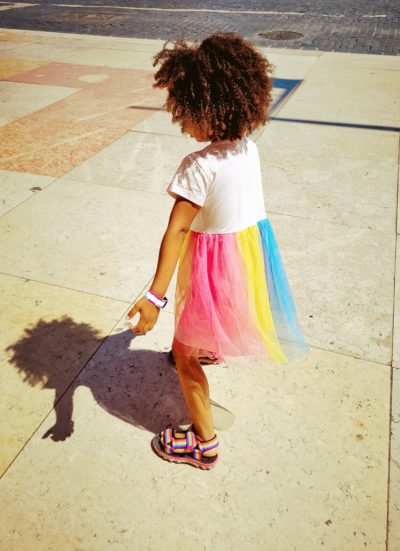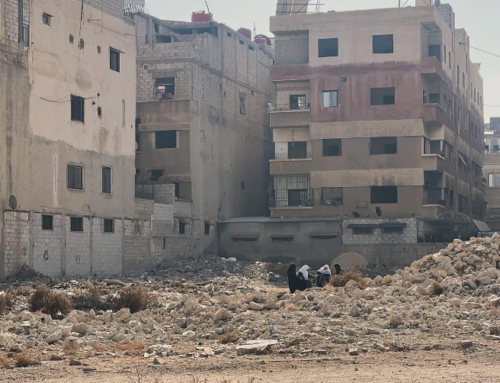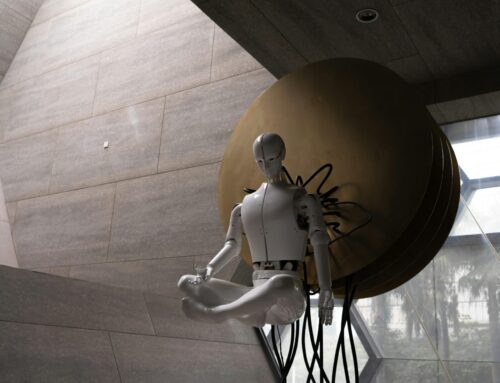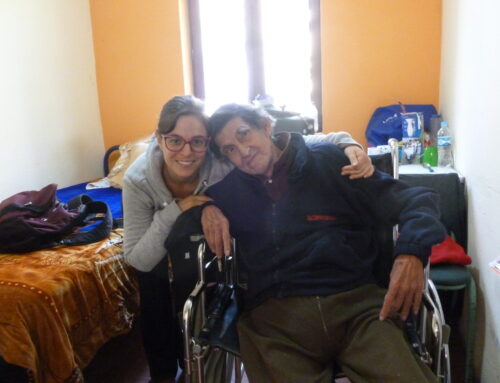
Our daughter, enjoying Pride festivities at Praça do Comércio in Lisbon. We were there for Andrea to conduct fieldwork in Portugal, which is the homeland of Tracy’s parents. Photo credit: Andrea S. Allen
We expected a fun dinner with a colleague. What we did not expect was to learn through pure serendipity the identity of our daughter’s anonymous sperm donor. We were talking sperm donation with one of Andrea’s colleagues. Tracy joked that what had appealed to her about the donor was his interest in ethics and love of board games, not his impressive height or water polo hobby: “Yeah, he is 6’3” and plays water polo, but like I care about that. Who even plays water polo?”
Tracy had already mentioned his profession, and at the mention of water polo, Andrea’s colleague—who unbeknownst to us also played water polo—froze for a moment before a mischievous smile appeared on their face. “I think I know your donor,” the colleague said simply. And so began one of the most unlikely relationships of our lives, one that raised many questions—questions about parenthood, relationality, kinship terms, and the nature of kinship for queer parents as well as for queer egg and sperm donors. These questions arise in the midst of an era of rapid social reconfigurations of all things family, but also one of resurgent homophobia and continuing family traditionalism in many quarters.
Lesbian motherhood often feels like a reconstitution at once radical and surprisingly prosaic. As Kath Weston notes, the lesbian mother is both “icon and conundrum” (1997, 169) because she re-introduces the saliency of biology in queer familial configurations even as this re-introduction downplays or further displaces biological supremacy as the defining characteristic of family. From the moment Andrea decided that she would try to become pregnant, she knew she would be carrying not just her baby, but our baby. Tracy was an essential partner in this process. We accorded value to blood, DNA, and biological influences, but didn’t reduce kinship ties to mere biology. We recognized that “All kinship relations are fictive” (Patton-Imani 2020, 81).
Since Tracy would be the non-biological mother of our child, we decided that we wanted a sperm donor who shared characteristics with her. But a suitable donor, someone sharing cultural and personal traits and who looked in some way like her, was not easy to find. Luckily, after months of searching, we found The Unicorn. Tracy and this donor are both Mediterranean, have PhD’s, and know several languages. They both love Scrabble, sci-fi, and pondering ethical questions. We rejoiced!
The donor, Aziz, had donated to the sperm bank anonymously but agreed to have his identity released once any child he helped produce turned 18. So, we had expected to know his identity in 2035, not in 2021. But once fate intervened, we opened ourselves up to the possibility of our family potentially being reshaped through the introduction of our sperm donor into our lives, and particularly into the life of our daughter.
Our first conversation with Aziz illustrated the possibilities, complications, and machinations of queer kinship. A few hours after messaging on Facebook, we met “face-to-face” on Zoom. Staring at the face of our sperm donor and not a blurry picture of him or snapshots of different parts of his face—all we had been given by the sperm bank—was a tremendous experience for us. As we spoke with and asked basic questions of each other, Aziz mentioned that another family had used his sperm to produce their three children.
As he discussed the children, he referred to one of them as “my daughter.” We were struck by this, and truth be told, Tracy’s back tensed up. As the non-biological mother of our daughter, she has sometimes worried her role was more tenuous. And here it was: that tension between biological and social relationality exemplified so well in just one word: daughter. What does it mean to have a daughter? To say my daughter? To Tracy, it meant that she had cared for our child from birth, that nurturing was a sufficient replacement for biology, love a monument better than gestation. If the donor could utter this phrase “my daughter,” what did this mean? But what other term could he even use besides daughter?
Between the three of us, we know twelve languages, yet none of those languages has a term for a relation between a man who anonymously donates sperm and the child he helps produce and will not raise. We would not refer to the offspring of a nonhuman mammal as a daughter but as an offspring. Humans that we are, however, offspring seems a stilted and strange term to use, as if our daughter were a four-legged creature. There is no word for the relation between Aziz and our child, not really. “Daughter” may be biologically or genetically accurate but is not socially or culturally indicative of their relationship.
Despite our queerness, Tracy and I had not given much thought to how our sperm donor would characterize and name his relationship with our daughter. A couple of months later, we raised our concerns with him—something that we were able to do because of the easy rapport we had established with a man who was in reality exactly how he had presented himself on paper. He told us that he does not actually use the phrase “my daughter” in front of the other family nor does he think that he is raising her. Instead, the phrase was an indication of his relationship with her and not her relationship with him. This is obviously an atypical use of the phrase, but if Aziz did not say daughter, what term could he even use? Is there a term that will not raise eyebrows or risk bruised feelings, a term that signifies—as other kinship terms do—a very particular form of relation? We know what the term uncle means, or stepmother, or widow. But if existing terms for family do not suffice, how do we generate new ones so that they can serve the purpose relationship words are meant to serve, which is to indicate how we relate?
Interestingly, Aziz’s use of the phrase “my daughter” was indicative of his own understanding of their relationship, more for his own discernment and less for others. This queer understanding of kinship terms invites new possibilities for the ways in which sexual and gender minorities who use egg/sperm donation, RIVF, and other forms of artificial reproduction are well-positioned to take an agentive role in the re-structuring and expansion of kinship terms.
Many queer people find it pivotal to exercise agency in choosing certain relationship words for themselves, a phenomenon that is lacking among the great majority of straight people. Often queer parents cannot fall back on the powerful language, models, and imagery of parenthood, either because these have been explicitly denied them or because the strictures involved seem not to encompass the contours of their identities. Paradoxically, these limitations can bring a greater agency and choice over language. But could any term that we generate for Aziz ever rival the discursive power of the word father? Could a term indicating donor offspring ever have the social potency of the words daughter and son? And would we even want them to?
Actually, our feelings toward Aziz’s use of the term daughter have shifted as we have grown closer to him. In the past year and a half, he has seen our daughter almost monthly. He came to her 5th birthday party and has met some of our friends. We message with him weekly. Considering the deep love we both feel for our daughter—a child that this man was pivotal in creating and one he has shown so much interest in getting to know—it is unsurprising that questions of terminology have grown less fraught as time passes.
As we reflect on our blossoming relationship, we contemplate what we want from and for Aziz and what he wants from us. These questions point us toward the paradoxes of this process of creativity generating human beings, human relations, and terms marking relations. We seek terms that capture who we are to each other, and yet, who we are is shaped by language that already exists. Even within the dominant linguistic systems of North America, English kin terms involve shades and contours revealing complexity. As Yondu stated to Peter Quill in Guardians of the Galaxy II: “He may have been your father boy, but he wasn’t your daddy.” In many ways, kinship has always been queer or “slant” (Ahmed 2006, 66-67). And so while we have an extraordinary tale to tell about how we met our donor, it is actually quite ordinary to ponder who you are to me, and who am I to you. Thus, as we displace but not always dismiss biology, we simultaneously re-imagine language as we conceptualize and create new ways of belonging, new modes of kinship.
Bibliography
Ahmed, Sara. 2006. Queer Phenomenology: Orientations, Objects, Others. Durham: Duke University Press.
Patton-Imani, Sandra. 2020. Queering Family Trees Race, Reproductive Justice, and Lesbian Motherhood. New York: New York University Press.
Weston, Kath. 1997. Families We Choose: Lesbians, Gays, Kinship, Revised Edition. Columbia University Press.
Cite As: Allen, Andrea S., and Lemos, T. M. 2023. “On Donors and Daughters: The Language of Queer Kinship “, American Ethnologist website, 28 March 2023 [https://americanethnologist.org/online-content/essays/on-donors-and-daughters-the-language-of-queer-kinship-andrea-stevenson-allen-and-tracy-m-lemos/]
Andrea S. Allen is Assistant Professor in the Department of Anthropology and the Centre for Diaspora and Transnational Studies at the University of Toronto. She received her PhD in anthropology from Harvard University. Her book Violenceand Desire in Brazilian Lesbian Relationships (Palgrave Macmillan 2015), highlights the experiences of lesbian women in Salvador, Bahia, Brazil, with sexual desire, infidelity, and intimate-partner violence. Allen’s current research project examines the experiences of LGBTQ Brazilian evangelicals in São Paulo and Lisbon.
T. M. Lemos is Professor of Hebrew Bible at Huron University College and a member of the graduate school faculty and the Centre of Transitional Justice and Postconflict Reconstruction at the University of Western Ontario. She is the author of two books, including Violence and Personhood in Ancient Israel and Comparative Contexts (Oxford, 2017), and the coeditor of three volumes, most recently The Cambridge World History of Genocide, Vol. 1 (2023). She has published works in biblical studies, Jewish Studies, genocide studies, and the history of violence. She is currently working on a comparative treatment of rehumanization, or recovery and healing from dehumanizing violence.




